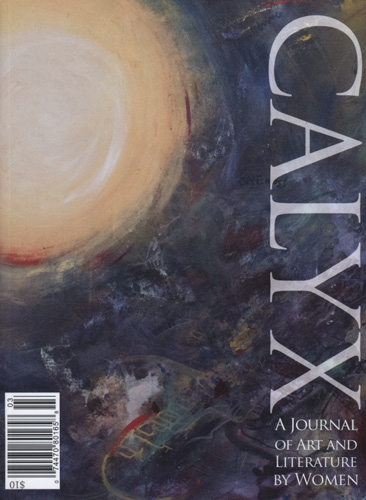CALYX – Fall 2015
Since 1976, CALYX has published art and literature by women. Senior editor Brenna Crotty describes this issue as a “search for meaning and identity.” More specifically, this issue resembles Cindy Cotner’s cover art, “Becoming.” The contributors examine how we become who we are, even as we grapple with the fact that often there is no recipe and no completion. Becoming is a continuous process.
Since 1976, CALYX has published art and literature by women. Senior editor Brenna Crotty describes this issue as a “search for meaning and identity.” More specifically, this issue resembles Cindy Cotner’s cover art, “Becoming.” The contributors examine how we become who we are, even as we grapple with the fact that often there is no recipe and no completion. Becoming is a continuous process.
The only nonfiction piece, Anne Warren Smith’s “Eating for Life” depicts identity formation through food centered vignettes. At the start, Smith’s transitions between vignettes depict a smooth route of cause to effect. She ends one section “They called me a natural homemaker. I said no. I wasn’t,” then immediately begins a new vignette with “Mother was the homemaker.” These simple transitions give way to a more nuanced narrative where food illustrates the futile search for a recipe of who we are. Smith knows that what she needs in her life cannot be measured, baked or plated, but she tries to find such an answer. Finally, Smith develops cancer and the neat cause to effect line is severed when she cannot find an explanation for her disease. At the end, Smith remains a work in progress. The essay was published posthumously.
Bindu Bansinath’s story “Boy” follows the development from boy to man. Colombian au pair, Cata, sees the path to manhood that her four-year-old white charge, Ralph, will take. Bansinath parallels Ralph with Cata’s adult white male lover. The second person narration means you, as Cata, do not see Ralph as the boy people adore for his white skin, but rather the boy who “hits your backside with the full thrust of a pillow.” In the same paragraph, you, as Cata, remember your lover’s “horny racial digs” and how he “smacks your behind.” A critique of masculinity, whiteness and privilege, Bansinath’s story projects the path of how we grow into our gender and our adult bodies.
“The White Shoes” photograph series by Nona Faustine also uses art as social critique. Faustine describes her photographs as a series of places “where the 250 years of slavery in New York can still be viewed through the lens of today.” In each photo, a Black woman stands nude wearing only white high heels and a shackle dangling from her wrist. In “From Her Body Sprang Their Greatest Wealth,” the model stands on an auction block in the middle of Wall Street. The photographs take an unapologetic stance that who we are cannot be separated from our collective past. Likewise, it is our collective responsibility to shape a more equal present.
CALYX publishes artists who respect women of all ages, and so I was struck when this was not the case in Judith Arcana’s prose poem “Persephone Talks to her Girlfriends on Her Cell Phone.” Arcana takes the Greek myth of Persephone and bends it into the mouth of a teenage girl. The result is insulting to young women. Arcana’s sentences are punctuated with likes and technology references. Persephone complains, “There’s, like, bad reception on everything—even my iPad cuts out like sometimes. And [Hades] still won’t let me go on Facebook.” There is no room for Persephone to become anything because there can be no growth from a flat female character.
“To the Poet, from the Poem” by Nicole Robinson is a dynamic piece which tackles the process of writing a poem of triggering material. Narrating as the poem, Robinson writes about molestation. She crafts the demanding voice which tells the poet “Just write it. Like this: ‘molested.’” The poem documents the struggle to write and how far we’ll go to keep such poems at a distance from who we’ve become.
The child narrator of “The History Professor” by Dinah Cox, draws the reader close. In this coming-of-age story, Cox creates Hazel, a character with subtle humor who describes her and her siblings as “not just weird but downright bizarre.” Underneath the humor lies the true story: Hazel’s father committed suicide and her mother has fallen into depression. It is only through meeting Hazel’s brother’s history professor that the family can begin to heal. The narrative is at once a traditional coming-of-age story, while also exploring how minor characters impact the trajectory of our lives.
Through the theme of becoming and growing into our current selves, CALYX draws upon an array of female voices who do not shy away from stories that leave characters and ideas in development. This issue of CALYX is its own coming-of-age story: loss of simplicity, a futile search for a straight life path, and an ongoing journey that does not end at the last word published.
[www.calyxpress.org]





